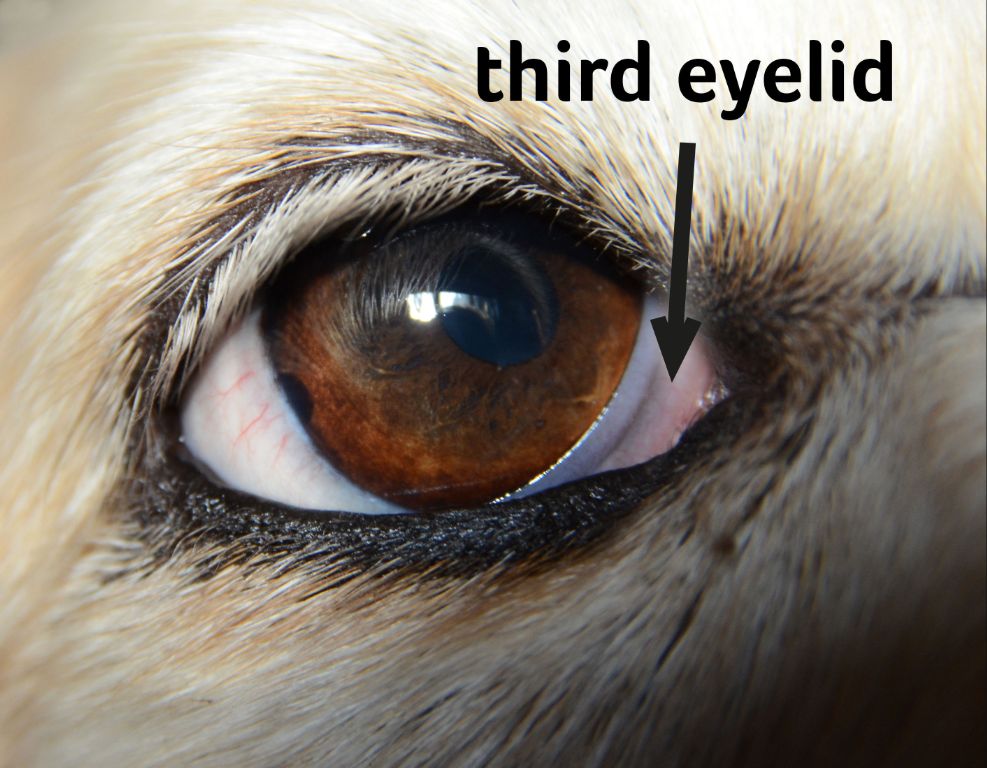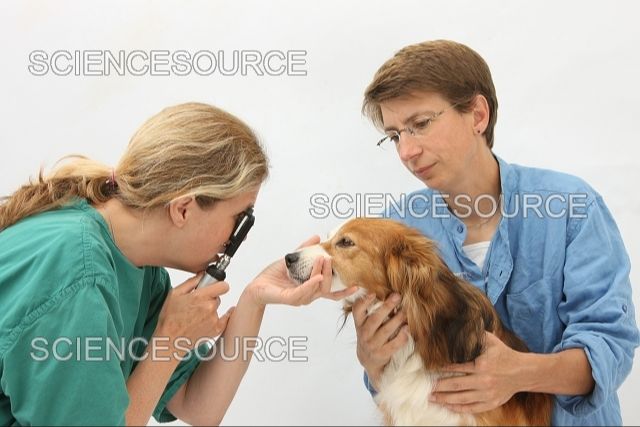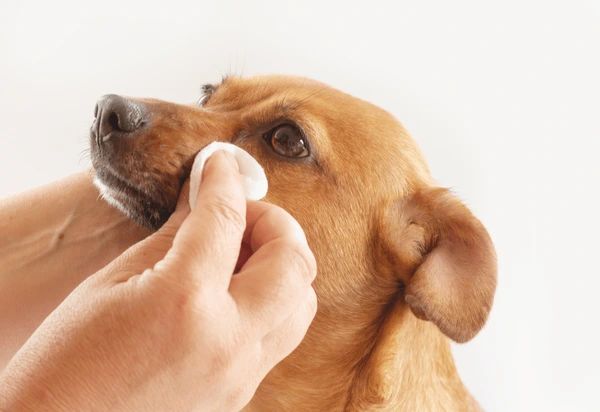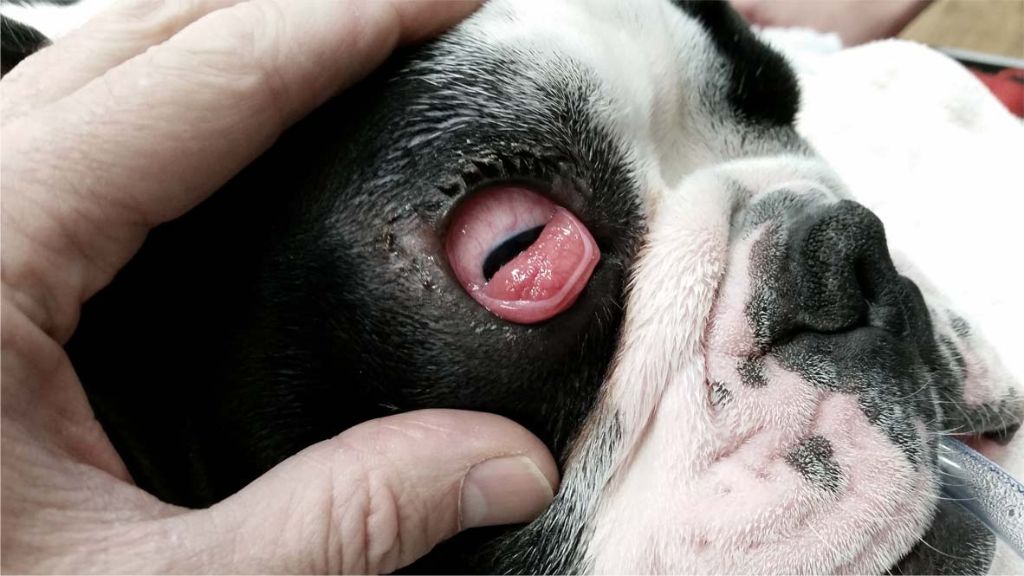What is the Third Eyelid in Dogs?
The third eyelid, also known as the nictitating membrane, is a protective structure found in the eyes of dogs and many other animals. Unlike humans, dogs have three eyelids – an upper and lower lid like humans, and a third lid located in the inner corner of the eye.
The purpose of the third eyelid is to help spread tears and other secretions across the surface of the eye to keep it moist, and to provide additional protection. When fully extended, the third eyelid covers roughly one third of the eyeball. It features a tear gland called the gland of the third eyelid which produces about one third of the aqueous, or watery, portion of a dog’s tears (All About Vision).
The third eyelid is made up of connective tissue, lymphoid tissue, and smooth muscles. It is connected to the eyeball by ligaments, so when the muscles contract it can slide out horizontally across the eye. In healthy dogs, the third eyelid is usually only visible when the dog is asleep or blinks. However, if the third eyelid is chronically exposed or swollen, it can indicate an underlying health issue.
Why Might a Dog’s Third Eyelid Show Suddenly?
There are several potential causes for a dog’s third eyelid to suddenly become visible:
Irritation or infection: The third eyelid can show due to irritation or infection of the eye itself or surrounding structures. Causes may include conjunctivitis, dry eye, trauma, foreign objects lodged in the eye, or eyelid abnormalities rubbing against the eye.[1]

Injury: Blunt trauma to the eye or head can cause the third eyelid to appear. This occurs because injury and swelling cause the eyeball to recede back into the socket, revealing the third eyelid. Car accidents, falls, or head trauma are potential causes.[2]
Illness: Systemic illnesses like canine distemper or conditions affecting nerves that control eye and eyelid motion can make the third eyelid visible. Horner’s syndrome, resulting from middle ear infections, can also cause third eyelid protrusion.[3]
Tumors or defects: Less commonly, cancers, growths or anatomical defects involving the third eyelid itself or surrounding structures may lead to its protrusion.
Signs and Symptoms
The most noticeable sign of the third eyelid protruding is the appearance of a “membrane” or thin tissue covering part of the eye. This pink tissue originates from the corner of the eye near the nose. It can cover a small or large portion of the eye depending on the underlying cause.
In addition to the protruding eyelid, other signs and symptoms may include:
- Redness and swelling of the third eyelid and surrounding eye tissue
- Discharge or crusting around the eye
- Squinting or spasms of the third eyelid
- Apparent vision problems – foggy eyes, reluctance to open eyes, clumsiness
- Restricted eye movement or inability to fully open the eye
The degree of third eyelid protrusion, swelling, and other symptoms can help a veterinarian determine the severity of the underlying cause. Mild irritation may only cause a small protrusion, while more serious issues like glaucoma can lead to a very enlarged, swollen, red third eyelid.
Diagnosing the Underlying Cause
Determining the underlying cause of a dog’s third eyelid suddenly showing often requires a veterinary examination and diagnostic testing. The vet will start with a complete physical exam, paying close attention to the eyes. They will look for signs of irritation, inflammation, or abnormalities with the third eyelid itself. Vets may also check eye pressure and use eye stains to look for ulcers or other problems.

Potential diagnostic tests the vet may recommend include:
- Bloodwork to check for infections, organ issues, or other systemic problems
- MRI or CT scan of the head/brain to check for neurological issues like Horner’s syndrome (https://stvopets.com/articles/tales-of-the-third-eyelid/)
- Biopsy of the third eyelid if growths or tumors are suspected
- Allergy testing if environmental allergies are suspected
Based on the exam findings and test results, the vet can diagnose the underlying problem causing the third eyelid exposure. This allows appropriate treatment to be recommended and started to resolve the condition.
Treatment Options
Treatment for a protruding third eyelid in dogs will depend on the underlying cause of the condition.
If there is an infection, inflammation, or irritation, the veterinarian may prescribe antibiotic eye drops or ointment for 7-10 days. Anti-inflammatory eye medications may also be used during this time. Oral antibiotics or anti-inflammatory medications may be prescribed for 5-10 days as well. These treatments can help reduce swelling and irritation of the third eyelid.
If there is a prolapsed gland or cherry eye, surgery may be recommended to reposition the gland back into its normal anatomical location so it functions properly again. This is considered the most effective treatment for long-term resolution of a prolapsed gland.[1]
In cases of tear production problems, medication like cyclosporine may be prescribed to reduce inflammation and stimulate better tear production to keep the eye lubricated.
Removing irritants, allergens, or foreign bodies may also help resolve third eyelid issues. Keeping the eye clean while medications take effect is also important.
Follow up exams will be needed to ensure the protrusion resolves and the eye heals properly. Ongoing medication or treatment may be required in chronic cases.
Home Remedies and Care
If your dog’s third eyelid is showing, there are some simple home remedies and care tips to provide relief and prevent further irritation:
Keep the eye clean and protected. Use a warm, damp cloth to gently wipe away any discharge or debris around the eye. Be very gentle and do not rub the eye. You can also use sterile eye wash made for pets to flush the eye if needed.

Apply warm compresses if swollen. Place a clean, warm, damp cloth or compress on the eye for 5-10 minutes, 2-3 times a day. This can help reduce swelling and irritation.
Do not touch or pull on the third eyelid. It is important not to manipulate or try to force the third eyelid back in place, as this can damage it.
Prevent your dog from rubbing at the eye. Use an Elizabethan collar if needed to stop them from aggravating the condition.
Keep your dog’s face and eyes free of hair. Trimming the hair can help prevent debris from getting trapped near the eye.
Follow your veterinarian’s at-home treatment recommendations. They may prescribe eye drops, ointments or other medication.
Preventing Third Eyelid Issues
There are some steps you can take to help prevent third eyelid problems in your dog:
Keeping the eyes clean and protected – Make sure to routinely clean around your dog’s eyes with a soft, damp cloth to remove any discharge or debris. Avoid letting shampoo or water get directly in their eyes during baths. You can also talk to your vet about eye lubricants or other products to protect the eyes.
Monitoring for signs of eye problems – Check your dog’s eyes daily for any redness, swelling, discharge or other abnormalities. Be alert for signs like excessive eye rubbing, squinting or pawing at the eyes. The sooner you catch any issues, the better.
Ensuring good eye health – Feed your dog a nutritious diet rich in vitamins and antioxidants for eye health. Limit exposure to irritants like dust, pollen or tobacco smoke. Make sure they get routine vet checkups to monitor for eye issues. Some breeds prone to eye problems may benefit from supplements.
With proactive care and awareness of eye health, you can often prevent or minimize third eyelid problems in dogs. But see the vet promptly if you notice any abnormalities.
When to See a Veterinarian
If your dog’s third eyelid suddenly appears and won’t retract, it’s a sign that something is wrong and you should have your vet examine it as soon as possible. Some key signs that warrant an urgent vet visit include:
- The third eyelid appears red, swollen or has discharge – This could indicate inflammation, infection or injury that requires treatment.
- There are vision or eye movement issues – If your dog seems to be having trouble seeing or moving their eyes, the underlying cause needs to be addressed.
- Your dog is squinting or pawing at their eye – Discomfort or irritation may be present.
- The eyelid won’t retract for more than a few days – Persistent third eyelid exposure needs to be evaluated.
- Your dog seems lethargic or depressed – This can be a sign of more serious illness.
While some third eyelid exposure may resolve on its own, it’s always best to have your vet examine it to determine the cause and appropriate treatment. Ignoring it risks potentially permanent vision damage or loss. Early intervention leads to the best outcome, so don’t delay in getting your dog evaluated.
For more information, see the American College of Veterinary Ophthalmologists’ overview on third eyelid diseases.
Outlook and Prognosis
The outlook and prognosis when a dog’s third eyelid is suddenly showing depends on the underlying cause. Some potential scenarios include:
– If due to an eye injury or trauma, the prognosis is often excellent with appropriate treatment such as medications and allowing time to heal. The third eyelid should return to its normal position once swelling and inflammation resolve.
– With corneal ulcers, the prognosis is good if treated early before the ulcer worsens. Medications, eye drops, and sometimes surgery may be needed for healing.
– For eye issues caused by an underlying disease, the prognosis depends on the disease. For example, with glaucoma, lifelong treatment and monitoring will be needed to preserve vision.
– If cherry eye surgery is required to tack the gland back into place, the prognosis is very good. In most cases, the third eyelid returns to normal after surgery and healing.

– For chronic conditions like allergies or dry eye, the third eyelid changes may recur periodically if the underlying problem persists. Long term management may be required.
In summary, the outlook is generally excellent with proper veterinary treatment targeted at the underlying root cause. But if a chronic condition is present, the third eyelid could show again on occasion requiring ongoing care and observation.
FAQs
Here are some frequently asked questions about a dog’s third eyelid suddenly showing:
Why did my dog’s third eyelid start showing suddenly?
There are a few potential reasons a dog’s third eyelid may suddenly become visible. According to Everyday Medicine: The Third Eyelid, it could be due to illness, injury, irritation, or anatomical abnormalities. If the third eyelid is protruding in both eyes, it usually indicates a systemic illness or condition.
What are the symptoms of third eyelid issues in dogs?
Symptoms besides the third eyelid showing can include eye redness, swelling, squinting, discharge, crusting around the eyes, pawing at the eyes, sensitivity to light, and lethargy, according to Conditions of the Third Eyelid Factsheet. Other associated symptoms depend on the underlying cause.
How is a protruding third eyelid treated in dogs?
Treatment depends on the cause, but may include medication, surgery, addressing any underlying illness, and keeping the eye clean. Mild irritation may be treated with antibiotic eye drops or ointment. Cherry eye and cartilage abnormalities often require surgery. Addressing dehydration, infection, or other illnesses can allow the third eyelid to retract normally.
How can I prevent my dog’s third eyelid from protruding?
There’s no way to guarantee the third eyelid won’t show, but keeping your dog healthy through proper nutrition, exercise, routine vet care, and prompt treatment of illnesses can reduce the chances. Avoiding eye injuries through proper toys and supervision also helps. Genetics play a role in anatomical issues.
When should I take my dog to the vet for a protruding third eyelid?
According to Animal Eye Care, you should see a vet promptly if the third eyelid is showing in both eyes, there is discharge, swelling, or redness, your dog seems in pain, or the condition doesn’t improve in 1-2 days. Seek emergency care for trauma, sudden onset, or significant redness/swelling.
